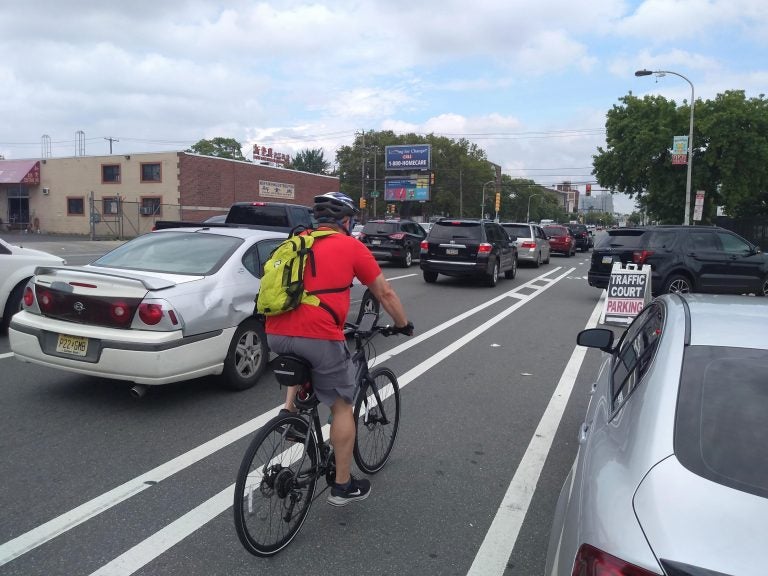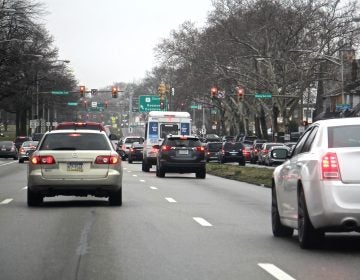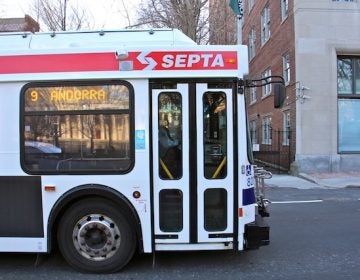Philly has $800K to make Spring Garden the bike path of our dreams but the clock is ticking
Spring Garden Street through Center City may only be 2.1 miles long, but it represents an opportunity for the cycling community — in Philadelphia and across the East Coast.

File photo: A man rides his bike on Spring Garden Street in 2019. (Courtesy of Bicycle Coalition of Greater Philadelphia)
Spring Garden Street through Center City may only be 2.1 miles long, but it represents an opportunity for the cycling community — in Philadelphia and across the entire East Coast.
In 2009, the street was selected through a Center City Greenway Feasibility Study conducted by Pennsylvania Environmental Council as the East Coast Greenway alignment through Philadelphia. As a recognized greenway, the corridor would act as the city’s official east-west trail connection between the Delaware and Schuylkill River Trails, completing the city’s segment of the 3,000-mile-long traffic-separated bicycling and walking path that runs from Calais, Maine to Key West, Florida.
Already, Spring Garden Street already has some of the most-ridden bike lanes in Philadelphia, used by about 150 people on bikes per hour getting to work, school, the grocery store or wherever they need to go.
And with the city’s new plans for protected bikeways along American Street, Second Street, Fifth Street, Sixth Street, Tenth Street, and 13th Street (all of which would connect with Spring Garden), we’re about to see even higher daily bike traffic on Spring Garden Street.
But since the plan was originally birthed in 2009, there’s been little progress on Spring Garden.
The city has made few strides in turning the corridor into what it could be: a major artery that includes a safe, separated path for cyclists, whether they’re getting to work, on a recreational bike ride between the Schuylkill and Delaware River Trails or taking a once-in-a-lifetime ride up or down the East Coast Greenway.
The Department of Conservation and Natural Resources has already provided one extension to the Streets Department for a $400,000 grant to realize that vision, but that money is due to expire by the end of 2019.
It’s time the city picks up on the work that’s already been done by advocacy organizations and turn Spring Garden into the street Philadelphians deserve.
While Spring Garden Street hasn’t been re-engineered, it’s not because of a lack of work that’s gone on behind the scenes.
A 2013 assessment was conducted by Pennsylvania Environmental Council (PEC) and others with robust community outreach, resulting in conceptual design.
In late June 2015, in response to five years of work conducted by the City and PEC, the City of Philadelphia received the $400k grant from the Delaware Valley Regional Planning Commission’s Regional Trail Fund to match a $400,000 grant from the Department of Conservation and Natural Resources (DCNR) to prepare a preliminary design of the corridor.
Between 2015 and 2018, PEC continued its public outreach along the entire corridor, through meetings, rides, popup bike lanes, and happy hours.
Even with the $800,000 in hand, the two grants comprise a small portion of final design costs—not to mention the project’s construction. Full design is estimated to cost between $3 and $6 million and construction, $23 to $25 million. Why so much? The plan likely involves taking out the center median on Spring Garden; an original plan for the corridor involved a center bikeway in the media, though that plan has been scrapped.
As reported by the Bicycle Coalition of Greater Philadelphia, the Streets Department has been developing work orders to hire two firms to start on design: one firm will provide strategic guidance and the other will do the engineering work.
Additionally, a measurement of Spring Garden Street conducted by the Bicycle Coalition of Greater Philadelphia found there is enough room on the road, now, to flip the parking and bike lane east of Broad Street. As proposed in an article for Metro Philadelphia in May 2018, the city should flip the lanes and consider eliminating parking on blocks where there is not enough room for traffic, parking, and a protected bike lane.
Spring Garden Street is not on the City’s High Injury Network, and the project will not be considered a Vision Zero project, but it’s a crucial bicycle commuting corridor that is currently too stressful for the majority of risk-averse cyclists who would be much more likely to ride if it included safer protected facilities. It will also create shorter crossing distances for pedestrians getting across the street.
In 2015, PEC reported that 21 percent of all crashes on the corridor involved bicycles. In May 2018, Pablo Avendano, a professional courier, was killed at the intersection of 10th and Spring Garden Streets.
The Bicycle Coalition, PEC, the East Coast Greenway Alliance and Feet First Philly (FFP) met with the Streets Department in January to ascertain the progress. The work order to hire the first consultant was just approved this month—which is the first movement on this project in a long time.
Four years is a long time to get started on a preliminary design project and many are anxious to see the Spring Garden Street Greenway become a reality. Given the way these things work, we’re probably looking at two to three more years for design, then another two years for construction.
Ultimately, the Spring Garden Street Greenway is about improving the quality of life for the local community by giving the adjacent neighborhoods and their institutions, businesses, offices and residences, a safer, more social, and more active main street.
It’s time for the city to move forward on this project and be transparent about the process. Philadelphia has waited long enough.
WHYY is your source for fact-based, in-depth journalism and information. As a nonprofit organization, we rely on financial support from readers like you. Please give today.







